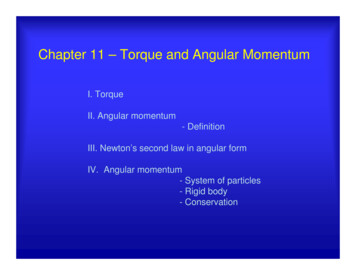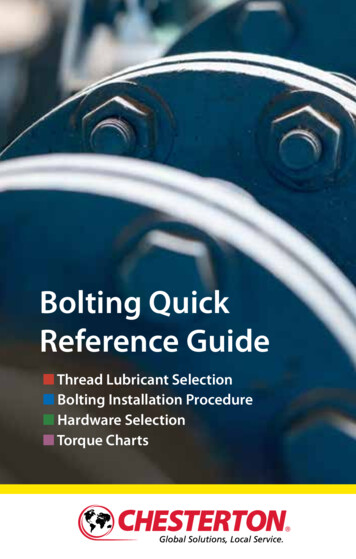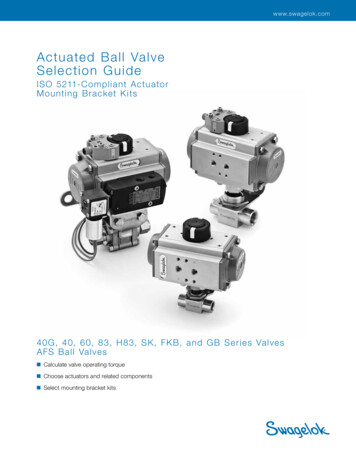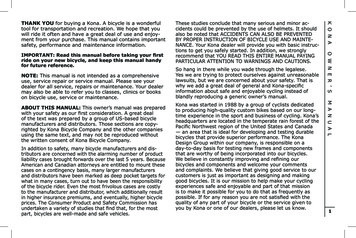
Transcription
Chapter 11 – Torque and Angular MomentumI. TorqueII. Angular momentum- DefinitionIII. Newton’s second law in angular formIV. Angular momentum- System of particles- Rigid body- Conservation
I. Torque τ r F - Vector quantity.Direction: right hand rule.Magnitude:τ r F sin ϕ r F (r sin ϕ ) F r FTorque is calculated with respect to (about) a point. Changing the point canchange the torque’s magnitude and direction.
II. Angular momentum- Vector quantity.Magnitude: l r p m( r v )Units: kg m2/sl r p sin ϕ r m v sin ϕ r m v r p (r sin ϕ ) p r p r m vDirection: right hand rule.l positive counterclockwisel negative clockwiseDirection of l is always perpendicular to plane formedby r and p.
III. Newton’s second law in angular formAngularLinear dpFnet dt τ net dl dtSingle particleThe vector sum of all torques acting on a particle is equal to the time rateof change of the angular momentum of that particle.Proof: dl dv dr l m( r v ) m r v m(r a v v ) m(r a ) dtdt dt dl r ma r Fnet r F τ netdt()V. Angular momentum- System of particles:n L l1 l2 l3 . ln lii 1
nn dldLdL i τ net ,i τ net dt i 1 dt i 1dtIncludes internal torques (due to forces between particles within system)and external torques (due to forces on the particles from bodies outsidesystem).Forces inside system third law force pairs torqueint sum 0 Theonly torques that can change the angular momentum of a system are theexternal torques acting on a system.The net external torque acting on a system of particles is equal to the timerate of change of the system’s total angular momentum L.
- Rigid body (rotating about a fixed axis with constant angular speed ω):li (ri )( pi )(sin 90 ) (ri )(mi vi )Magnitudevi ω rili ri mi (ω ri ) ω mi ri 2Direction: li perpendicular to ri and pi n Lz liz mi ri ω mi ri 2 ω Iωi 1i 1 i 1 Lz ω Inn2dLzdωdLz I Iα τ extdtdtdtL IωRotational inertia of a rigidbody about a fixed axis
- Conservation of angular momentum: dLNewton’s second lawτ net dtIf no net external torque acts on the system (isolated system)Law of conservation of angular momentum: Li L f dL 0 L ctedt(isolated system)Net angular momentum at time ti Net angular momentum at later time tfIf the net external torque acting on a system is zero, the angularmomentum of the system remains constant, no matter what changes takeplace within the system.
If the component of the net external torque on a system along a certainaxis is zero, the component of the angular momentum of the systemalong that axis cannot change, no matter what changes take place withinthe system.This conservation law holds not only within the frame of Newton’smechanics but also for relativistic particles (speeds close to light) andsubatomic particles.I i ωi I f ω f( Ii,f, ωi,f refer to rotational inertia and angular speed before and afterthe redistribution of mass about the rotational axis ).
Examples:Spinning volunteerIf Ii (mass closer to rotation axis)Torque ext 0 Iiωi If ωfωf ωi
Springboard diver- Center of mass follows parabolic path.- When in air, no net external torque about COM Diver’s angular momentum L constantthroughout dive (magnitude and direction).- L is perpendicular to the plane of the figure(inward).- Beginning of dive She pulls arms/legs closerIntention: I is reduced ω increases- End of dive layout positionPurpose: I increases slow rotation rate less “water-splash”
RotationTranslation FForceLinear momentum p P pi MvCOMLinearmomentum(system of particles,rigid body)Newton’ssecond lawi P cte(Closed isolated system) l r pAngular momentumAngularmomentum L liSystem of particlesiL Iω dPF dtConservation law τ r F TorqueNewton’ssecond lawRigid body, fixedaxis L componentalong that axis. τ net dL dtConservation law(Closed isolated system) L cte
IV. Precession of a gyroscopeGyroscope: wheel fixed to shaft and free tospin about shaft’s axis.Non-spinning gyroscope dLτ dtIf one end of shaft is placed on a supportand released Gyroscope falls byrotating downward about the tip of thesupport.The torque causing the downward rotation (fall) changesangular momentum of gyroscope.Torque caused by gravitational force acting on COM.τ Mgr sin 90 Mgr
Rapidly spinning gyroscopeIf released with shaft’s angle slightly upward firstrotates downward, then spins horizontally aboutvertical axis z precession due to non-zero initialangular momentumSimplification: i) L due to rapid spin L due toprecessionii) shaft horizontal when precessionstartsL IωI rotational moment of gyroscope about shaftω angular speed of wheel about shaftVector L along shaft, parallel to rTorque perpendicular to L can only change theDirection of L, not its magnitude. dL τ dt dL τdt Mgrdtdϕ dL Mgrdt LIω
Rapidly spinning gyroscope dL τ dt dL τdt MgrdtdL Mgrdtdϕ LIωPrecession rate:Ω dϕ Mgr dtIω
Units: kg m 2/s. III. Newton’s second law in angular form dt dp Fnet Linear Angular dt dl net τ Single particle . Net angular momentum at time ti Net angular momentum at later time tf. If the component of the net external torque on a system along a certain axis is zero, the component o










